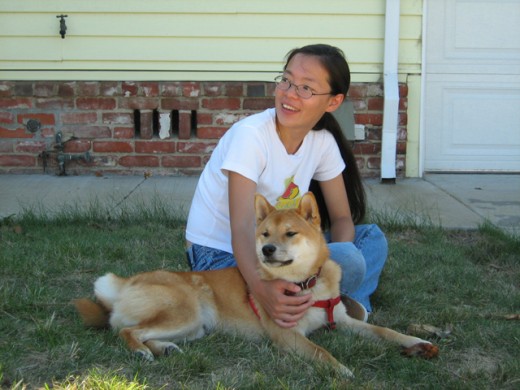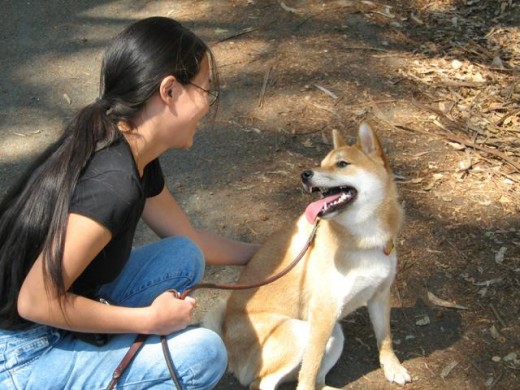I had a rough start with my Shiba Inu, Sephy.
Shiba Inus can be a challenge to care for, especially as a first dog. I wanted to do my very best for my Shiba Inu puppy but I still made many mistakes.
This is the story of Shiba Inu Sephy and me.

Shiba Inu and Alpha Rolls
Because I was new to dogs, and Shiba Inus, I asked my breeder many questions. She recommended that I check out Cesar Millan, The Dog Whisperer for dog obedience training tips.
Alpha Rolls
NOTE: Do not perform alpha rolls on any puppy. Even traditional trainers agree that aversive techniques are not appropriate for young dogs and puppies.
However, you can start training your puppy early with reward dog training.
After 4 days, I took Sephy to the vet and she recommended that I return him because he was mouthy and not well behaved. The vet technician recommended that I check out Cesar Millan, and taught me how to implement alpha rolls.
I had already fallen in love with Sephy and was not about to give up on him so I bought some DVDs of The Dog Whisperer and started to do alpha rolls.
The results were bad. Shiba Inus are a feisty, stubborn, strong-willed breed, and my little Shiba fought every time I did an alpha roll on him. While he would be slightly subdued after an alpha roll, he would quickly go back to chewing everything, running around crazily, knocking things down, jumping on every piece of furniture, mouthing on me and other people, and much more.
Life became very difficult for both Shiba Inu Sephy and me.

Training My Shiba Inu

I signed Sephy up for a SIRIUS puppy class to help with his dog socialization skills and I also got a private trainer who is well-versed in aversive dog training.
After watching The Dog Whisperer, I was under the impression that I could only be pack leader if I showed my Shiba Inu who was boss through more forceful aversive methods.
All aversive methods deliver an unpleasant stimulus to the dog.
Some techniques such as the leash jerk and the electronic collar deliver pain. Saying that such techniques do not deliver pain, and is only used to get a dog’s attention is rubbish.For such techniques to work effectively, it must deliver the proper level of pain so as to motivate a dog to follow our commands which will ultimately stop the pain. On the other hand, aversive methods may get more consistent and prompt responses, in the short-term, because pain is a strong motivator.
Sephy responded extremely well to my private trainer, Gary. Gary is extremely good with dogs and fearless. My Shiba would act out from time to time and mouth over Gary’s arms but he was able to easily stop this with some leash jerks (using a flat collar).
One time Sephy even placed his jaws on the trainer’s neck while being held, but Gary kept on holding him and had no problems calming Sephy down.
Gary taught me how to train my Shiba Inu using leash jerks or leash corrections. He cautioned me against over correcting and to always try and set Sephy up for success. He also instructed me not to give eye contact during corrections, and whenever possible, to try and redirect the source of corrections away from myself.
Sephy enjoyed his weekly one hour training lessons very much, and always gave Gary many licks. This experience showed me that aversive methods can sometimes work well if implemented by an expert with the right energy.

Walking with My Shiba Inu
Leash Corrections
If you decide to use leash jerks or other aversive techniques, it is important to apply them with the proper timing, force, and redirection.
If you apply a leash jerk with too little force, it will have no effect, and may even backfire and intensify your dog’s behavioral issues.
When properly applied, leash corrections will cause pain to the dog. If you do not want to apply pain to your dog, then do not use leash corrections or other pain based aversive methods.
Sephy responded well to my leash jerks initially.
However, when he was extremely excited, for example when meeting other dogs, my jerks would have no effect. Our trainer ultimately recommended that I try out the prong collar and showed me how to fit it and put it on properly.
DO NOT try to slip a prong collar over your dog’s head like you do a choke chain. Refer to Prong Collar Info for proper instructions on how to use a prong collar.
People commonly refer to the prong collar as providing power steering for leash jerks. I.e. the prong amplifies the force of your leash jerks, thereby delivering more pain and a greater aversive stimulus to the dog.
The prong collar was extremely effective initially. I was always worried about hurting my Shiba Inu, so my leash jerks tended to be too soft. With the prong collar, they were just right.

My Shiba Inu and His Dog Walker


At this time, I also enlisted the services of a dog walker/trainer, Betty (not her real name).
Betty also prescribes to the Cesar Millan, physical dominance type training. This suited me well at the time, because Betty did leash jerks and I thought consistency in techniques would be a good thing.
However, the situation started to go down hill from here.
Sephy became extremely sensitive towards handling. He would also constantly challenge Betty, by leash biting, hand biting, and doing alligator rolls (rolling on the ground to resist moving). Sephy also discovered that Betty really dislikes his high-pitched Shiba scream, and would constantly do this to great effect.
Betty did her best in trying to control the situation but her flavor of dog obedience training was clearly not working well. Finally, she wanted to escalate her leash jerks by using a choke chain.
Given the possible dangers of choke chains I decided that they are not an option.

I Did Not Choose Wisely

At this point, the leash jerks were also becoming less and less effective for me.
My Shiba was becoming habituated to them.
I was not implementing the leash jerks quickly enough so sometimes they were more like tugs and thus had no effect. I was also over-correcting and my leash jerks did not have enough force even with the prong collar.
To continue with aversive techniques, I would have to escalate the force of my leash jerks or switch to the electronic or shock collar. I was unwilling to go down this extreme path, so I decided to explore all other dog training possibilities.

The Right Kind of Shiba Training
Reward Dog Training
I stopped dog walking with Betty and started looking for a new dog trainer.
This time I checked out all types of trainers, rather than just the Cesar Millan, aversive type trainers.
While doing this, I received a fair amount of insults, scolding, and rabid preaching from trainers of the other camp, the reward dog training camp.
I always think it is rather ironic that many of the books and people who support the use of reward training (positive reinforcement training) would resort to aversive methods (insults, rabid preaching) when trying to convince other people of the effectiveness of their positive reinforcement methods.
Luckily, there were several reward dog trainers who practiced what they preached and based on their advice, I got the book Bones Would Rain From the Sky by Suzzane Clothier. After reading a few chapters,
I decided to stop using aversive methods and try using only reward obedience training.



I would like to say that reward dog training worked like a charm and from then on everybody lived happily ever after.
Reality, of course, is a bit messier. First of all Sephy gets bored easily; with everything, even his food.
For the reward methods to work I had to identify a variety of dog treats that he liked and cycle through them so that he remains motivated throughout the day. I also got a greater variety of toys and used external opportunities, such as meeting other dogs and meeting people, as rewards.
Walking on a loose leash (without the use of leash jerks) was a bit challenging at first, but stopping and sometimes doing a 180 when the leash gets taut works very well.



I am a lot happier with reward obedience training.
Frankly, I do not have the temperament for implementing an aversive correction with enough force for my Shiba Inu. I was also losing my dog’s trust because I was over correcting and not protecting him from other people (e.g. dog walker) who were also over correcting him.
Sephy is responding much better to the reward methods and is more relaxed and happy.
Being an adolescent, he still misbehaves occasionally, but a lot less so than when I was using aversive methods, such as leash jerks and alpha rolls.
Shiba Inus are very strong willed and stubborn. A Shiba will almost always respond to an aversive stimulus by fighting back. The greater the stimulus, the more threat he feels, and the more he fights back.
This is not to say that aversive methods will never work on a Shiba Inu. As I discussed before, under the hands of an expert trainer (Gary), Sephy actually responded well to leash jerks. However, I have not seen him respond so with anyone else, even other experienced trainers.

What I learned from Shiba Inu Sephy:
- Get information from multiple sources and do not take what one person, even a popular trainer, says as truth. Do your own research and try out the techniques yourself.
- The “best technique” is different for every dog-owner pair. So called “experts” will try to brow beat you into using their favorite techniques by using moral arguments and/or by telling lies. The effectiveness of the different techniques will depend on your training skill (timing, delivery of stimulus), on your temperament, on your dog’s temperament, and on the current level of trust and respect between you and your dog. Be honest and let your own moral compass steer you.
- Start out with reward obedience training. With reward training there is very little risk of losing your dog’s trust. Unlike aversive training, I will not injure my dog physically or mentally if I make training mistakes. I follow the Nothing In Life Is Free (NILIF) program and try to be a fair but strong pack leader through the control of resources.
- Things can go really wrong with aversive methods. Our dog may misbehave more, get destructive or aggressive, lose respect and trust in us, get stressed and break down completely, run away, or get injured. Always get direction from a good professional trainer before trying out pain or dominance based aversive methods.
